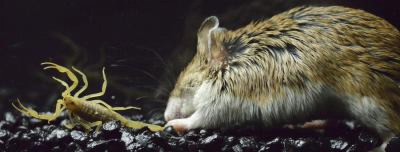Grasshopper Mice Numb To Scorpion Sting, Uses Evolutionary ‘Martial Arts’ To Block Pain [PHOTO]

A scorpion sting that would have most humans wailing barely bothers the grasshopper mouse.
Grasshopper mice have the ability to numb the pain caused by bark scorpions, making the scorpion toxin act as an analgesic instead of a pain stimulant, a new study suggests.
“This venom kills other mammals of similar size,” Ashlee Rowe, Michigan State University assistant professor of neuroscience and zoology, said in a statement. “The grasshopper mouse has developed the evolutionary equivalent of martial arts to use the scorpions’ greatest strength against them.”
The findings, published in the journal Science, may lead to the development of new pain management drugs in humans. In her research, Rowe tested whether grasshopper mice felt pain from the bark scorpion’s venom by injecting small amounts of the toxin or nontoxic saline solution into the mice’s paws. Overall, the mice tended to lick their paws, a usual reaction to a venomous toxin, much less when injected with the venom compared to the saline solution.
“This seemed completely ridiculous,” Harold Zakon, professor of neuroscience at the University of Texas at Austin, said. “One would think that the venom would at least cause a little more pain than the saline solution. This would mean that perhaps the toxin plays a role as an analgesic. This seemed very far out, but we wanted to test it anyway.”
Rowe and her colleagues discovered that grasshopper mice have a way to turn off pain pathways in their nervous system. Researchers found that the scorpion venom acts as an analgesic in grasshopper mice by binding to sodium channels in the mouse’s pain neurons, which blocks them from firing pain signals to the brain.
Scientists sequenced the genes for channels, known as 1.7 and 1.8, and found that the latter has different amino acids from those found in mammals that are sensitive to bark scorpion stings. The venom binds to these amino acids and shuts down the gate, preventing a pain signal from being sent to the brain.
“Incredibly, there is one amino acid substitution that can totally alter the behavior of the toxin and block the channel,” said Zakon.
It’s still not known which toxin elicits this reaction and why it isn’t lethal in mice. "If we could isolate that toxin and study exactly how it interacts with that channel, that could serve as a basis for an analgesic that would target [the same mechanism] in humans," Rowe said.
Grasshopper mice, rodents native to northern Mexico and the southwestern United States, are aggressive predators that chow down on spiders, crickets and other mice. They also eat Arizona bark scorpions despite their venomous stings capable of killing a small child, USA Today reports.
Rowe says the rodents, which may not be the only animals resistant to scorpion stings, could inspire medical developments in the human world.
"Some people might say, 'Why would you study grasshopper mice and bark scorpions?'" Rowe said. "There's a whole lot of things animals can do that we can't. ... There's potential for applying it to human biomedical problems, for sure."
© Copyright IBTimes 2024. All rights reserved.






















